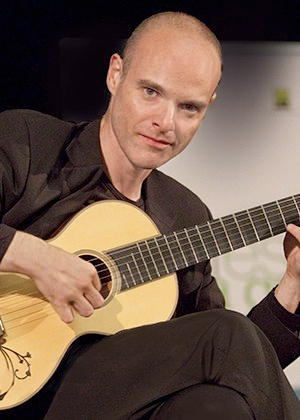by Robert Rollin

The highlight was Gallén’s stunning performance of Leo Brouwer’s Sonata del Pensador (“Sonata of the Thinker”), No. 4 (2013). Brouwer, himself a guitar virtuoso, explored experimental music by Iannis Xenakis and Luigi Nono in the ‘60s, and later recorded many modernist works. Guitarists admire his compositions because he writes so idiomatically for the instrument.
The first movement, Recuperación de la Memoria (“Memory Recovery”), presented two alternating contrasting ideas: an asymmetrical, almost non-metric one, and a hectic bebop jazz-sounding one. Among the beautiful special effects were doubled octave motion, harmonics, a gorgeous flautando sound, intense rasgueado technique (the powerful flamenco strumming effect), Bartók pizzicato (snapping the string against the fingerboard), and pungent low register adjacent minor seconds that resonated in the hall with wonderful intensity. The sheer speed and clarity of the rapid jazz passages were astonishing.
Iluminaciones (“Lightings” or “Illuminations”) also presented two prevailing moods: one slow and meditative, the other more blues-like, sometimes reverting to the earlier rapid jazz texture. Here Gallén demonstrated his amazing ability to create dramatic color change while playing with flawless technique.
Elogio de la Meditacion (“In Praise of Meditation”) recapitulated the blues-like idea, then segued to the rapid final movement, Celebración de la Memoria (“Celebration of Memory”). The furiously racing jazz idea reappeared to end the piece on a powerful rasgueado chord.
The balance of the program was dedicated to Fernando Sor’s three sonatas. The Andante largo of the Grande Sonata, Op. 25, contains some fine contrapuntal treatment, interesting chromatic harmony, and attractive antiphonal writing contrasting the high and low registers of the instrument — features that Gallén performed very expressively.
The Mozartian Allegro non troppo followed without pause, giving Gallén the opportunity to exploit charming tremolos and to highlight great dynamic contrasts. The Theme and Variations sparkled with Classical elegance. The final Menuetto resembled those of Haydn’s middle-period string quartets. Graceful ascending chromatic sequences and forte surprises were notable.
The Grand Sonata in C, Op. 22, has a more conventional four-movement structure. The opening Allegro sparkled with a lively, Haydnesque style. The Adagio was soulfully expressive. The Menuetto-Allegro dragged a bit, but the following amusingly short Rondo-Allegretto added a note of unpredictability.
The sedate single-movement Sonata in C, Op. 15(B) presents some interesting chromatic harmony. A galloping triplet accompaniment enlivens its duple meter.
After the Brouwer Sonata, Gallén returned for a much-demanded encore. Since his most recent recording on the Eudora label spotlighted all four of Sor’s sonatas, it was no surprise that Gallén performed the fourth and earliest as his encore: The Grand Solo in D, Op. 14. Considering how early it came in Sor’s guitar output, the movement sported a surprisingly adventurous development section akin to Beethoven, as well as some lovely dynamic contrasts. All these elements scintillated in the talented performer’s flawless performance.
Published on ClevelandClassical.com June 14, 2016.
Click here for a printable copy of this article



